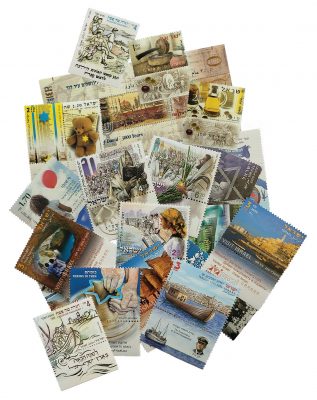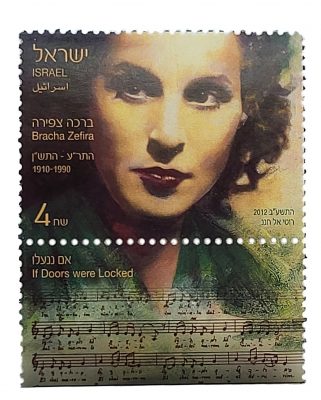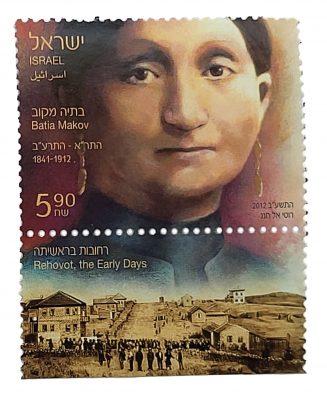×


We have detected your country as:
Please click here to go to the USA website or select another country from the dropdown list.
by: Janet Aslin, BFP Staff Writer
 When mailing letters I often ask the postal clerk, “I’d like some pretty stamps, please.” With the advent of email and free video calls via WhatsApp or Facebook Messenger, handwritten letters are becoming things of the past, with less and less need for postage stamps—never mind pretty ones. But in Israel, more than any other country, postage stamps are not just the means to get a letter delivered; they are a way to remember.
When mailing letters I often ask the postal clerk, “I’d like some pretty stamps, please.” With the advent of email and free video calls via WhatsApp or Facebook Messenger, handwritten letters are becoming things of the past, with less and less need for postage stamps—never mind pretty ones. But in Israel, more than any other country, postage stamps are not just the means to get a letter delivered; they are a way to remember.
As a die-hard letter-writer, I can say that Israel’s stamps have never disappointed me in their variety and significance. They remind us of specific events in Israel’s history, display the natural beauty of the Land, depict influential leaders as well as lesser-known Israelis or call to remembrance the biblical foundation upon which much of the nation’s daily life revolves. Taken as a whole, Israel’s postage stamps are an excellent way to learn about the Land—its past and present, its hopes and dreams, its struggles and successes.
One of Israel’s most colorful biblical stamps is the “High Priest’s Breastplate” and the corresponding set of twelve stamps with individual stones—sardius, topaz, emerald, turquoise, sapphire, diamond, jacinth, agate, amethyst, beryl, onyx, jasper—each engraved with the name of one of the sons of Jacob (from Exod. 39:10–14).
Over the years, many stamps have been issued in commemoration of the Fall Feasts (Lev. 23:23–43) and other biblical holidays. This whimsical series shows the building of a sukkah (booth) for the Feast of Booths and the joyful dancing with a Torah (Gen.–Deut.) scroll on Simchat Torah (rejoicing in the Torah—a day when the Torah reading ends and begins anew each year).
 Remembering people is woven throughout Jewish tradition, and there are many postage stamps that reflect this.
Remembering people is woven throughout Jewish tradition, and there are many postage stamps that reflect this. Two stamps help us remember two women who contributed to the modern State of Israel in distinctly different ways. Bracha Zefira (1910–1990) was born in Jerusalem to Yemenite parents and orphaned when she was just three years old. She became a folk singer and actress who helped to create a new style of Middle Eastern Jewish music during her long career.
Two stamps help us remember two women who contributed to the modern State of Israel in distinctly different ways. Bracha Zefira (1910–1990) was born in Jerusalem to Yemenite parents and orphaned when she was just three years old. She became a folk singer and actress who helped to create a new style of Middle Eastern Jewish music during her long career.
In contrast, there is little information available in English about Batia Makov (1841–1912). Her commemorative stamp says, “Rehovot–the early days.” We know that Rehovot was founded in 1890 during the First Aliyah (immigration to Israel) by Polish Jews. The early beginnings were difficult, as families like Batia’s struggled to turn uncultivated wasteland into productive agricultural fields. As we look into her face of determined resolve, we catch a glimpse of the fortitude of those early pioneers.
When the Israelites followed Joshua across the Jordan River to conquer the Land of Israel, they faced challenges like the walled city of Jericho. Thousands of years later, when the Lord began bringing His people back from the four corners of the earth, they faced the challenge of bringing a desolate land back to life. In three stamps reflecting “50 Years of Settling the Golan, Judea/Samaria and the Jordan Valley” we see the fruit of that labor—apples, dates and Jewish youth waving the Israeli flag.
World War II was a somber time for Jews living in British Mandate Palestine. Aware of the tragedy of Jewish lives being snuffed out during Hitler’s Holocaust, many volunteered to go and fight in Europe. A set of six stamps commemorates those volunteers, some of whom parachuted into Occupied Europe and others who fought as partisans or in the Allied Forces.
During the Six Day War of 1967, when Lt. Gen. Motta Gur broadcast these now-famous words, “The Temple Mount is in our hands!”, he signaled the return of the Jews to the Old City and the reunification of Jerusalem. The city was once again whole! Fifty years later, a commemorative sheet that reflects Jerusalem—old and new—shows men praying at the Western Wall on the right and a modern skyscraper on the left. Second only to the establishment of the State of Israel, the reunification of Jerusalem is a treasured memory.
When I set out to write this article, an Israeli friend made my task so much harder by bringing me a box filled to the brim with stamps. As I slowly looked through the contents of the box, I was overwhelmed. The Israel Postal Company has done an outstanding job of documenting the foundations, momentous events and people that make up this incredible Land. I have chosen only a few stamps to highlight in this article. They are only the tip of the iceberg, so to speak.
Photo Credit: Click on photo to see photo credit
All logos and trademarks in this site are property of their respective owner. All other materials are property of Bridges for Peace. Copyright © 2024.
Website Site Design by J-Town Internet Services Ltd. - Based in Jerusalem and Serving the World.